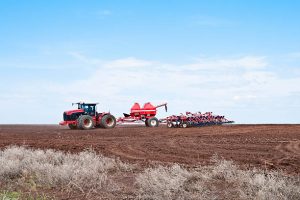The seed drill is a piece of farm equipment that is used to plant seeds in rows. It consists of a hopper that holds the seeds, a metering mechanism that drops the seeds at the correct spacing, and a series of colters that open up the soil and cover the seeds.
Seed drills can be pulled by tractors or horses, and they can be used to plant a wide variety of crops, including corn, soybeans, wheat, and rice. Seed drills are an important part of modern agriculture, as they help to ensure that crops are planted evenly and at the correct depth, which can lead to increased yields.
There are many different types of seed drills, each of which is designed for a specific purpose. For example, some seed drills are designed for planting small seeds, such as carrots and lettuce, while others are designed for planting large seeds, such as corn and beans. Some seed drills are also equipped with fertilizer applicators, which can be used to apply fertilizer to the soil at the same time that the seeds are planted.
Seed drills have been around for centuries, but they have become increasingly sophisticated in recent years. Today, many seed drills are equipped with GPS guidance systems, which allow them to plant seeds with even greater precision. This can help to further improve yields and reduce the need for herbicides and pesticides
Agriculture has come a long way throughout history, with innovations constantly shaping the way we cultivate crops. One such groundbreaking invention was the seed drill, which revolutionized the way seeds were planted and significantly increased agricultural productivity. In this comprehensive article, we will delve into the fascinating history and evolution of the seed drill, exploring its origins, the inventors behind it, and the impact it had on farming practices. So, let’s embark on a journey through time to discover how this ingenious machine transformed the world of agriculture.
Ancient Origins of Seed Planting
Before we dive into the story of the seed drill, let’s take a step back and explore the ancient origins of seed planting. For thousands of years, farmers relied on manual methods to sow their seeds. Hand broadcasting was the most common technique, where seeds were scattered haphazardly across the plowed and harrowed ground. While this method allowed for some seeds to take root, it was highly inefficient and led to uneven distribution and wastage.
Jethro Tull: The Pioneer of Agricultural Innovation
The seed drill as we know it today may be attributed to the inventive mind of Jethro Tull, an English agriculturalist born in Basildon, Berkshire, in 1664. Tull, who initially trained as a lawyer, turned his attention to farming on his father’s land in 1700. It was during this time that he became deeply interested in improving agricultural processes and finding more efficient ways to sow seeds.
The Birth of the Seed Drill
In 1701, Jethro Tull unveiled his revolutionary invention: the horse-drawn mechanical seed drill. This ingenious machine incorporated a rotating cylinder with grooves that allowed seeds to pass from a hopper above to a funnel below. The seeds then traveled through a channel created by a plow at the front of the machine and were immediately covered by a harrow attached to the rear. This method ensured that the seeds were planted at regular intervals, at a consistent depth, and in straight lines, minimizing waste and maximizing harvest yields.
Early Challenges and Adoption
Despite the undeniable advantages of Tull’s seed drill, it faced initial skepticism in England. However, across the Atlantic, American colonists quickly recognized the potential of this innovative technology and readily adopted it. Back in England, it would take some time before Tull’s seed drill gained widespread acceptance and replaced the traditional method of hand broadcasting.
The Impact of the Seed Drill
The introduction of the seed drill had a profound impact on agriculture, not only in terms of efficiency but also in terms of crop yields. With the ability to plant seeds in a more secure and uniform manner, farmers experienced significant improvements in seed germination. The seed drill ensured that seeds were firmly rooted in the soil, protected from birds, and provided with optimal conditions for growth. This, in turn, led to higher agricultural productivity and played a crucial role in the agricultural revolution of the eighteenth and early nineteenth centuries.
Jethro Tull’s Agricultural Innovations
Beyond the seed drill, Jethro Tull made several other significant contributions to agricultural innovation. He recognized the importance of plant nourishment and theorized that plants should be more widely spaced to allow for thorough soil breakdown during growth. Tull also believed that loose soil surrounding plants would foster better growth, reducing the need for manure. However, his theory on the value of manure was met with much criticism at the time.
Continued Agricultural Advancements
While Tull’s theories and techniques faced some skepticism, they laid the foundations for modern techniques of sowing and cultivation. Over time, other inventors built upon Tull’s seed drill, making further improvements and refinements. In 1782, gears were added to the distribution mechanism, enhancing the functionality and efficiency of the machine. These advancements in seed drill technology paved the way for continued progress in agricultural practices.
The Legacy of Jethro Tull
Jethro Tull’s contributions to agriculture were immense, and his legacy lives on today. His innovative seed drill revolutionized the way seeds were planted, increasing efficiency, and improving crop yields. Tull’s ideas and inventions influenced future generations of farmers and agricultural innovators, inspiring further advancements in farming technology.
Conclusion
The seed drill, pioneered by Jethro Tull, stands as a testament to human ingenuity and the power of innovation in shaping the world of agriculture.
From ancient manual methods of seed planting to Tull’s mechanical invention, the evolution of the seed drill has transformed the way we cultivate crops. As we look to the future, we can only imagine the continued advancements that will further enhance agricultural productivity and sustainability.
So let us remember Jethro Tull, the agricultural pioneer who forever changed the landscape of farming with his ingenious seed drill.




